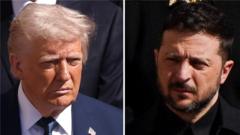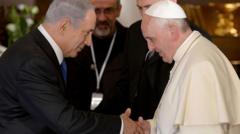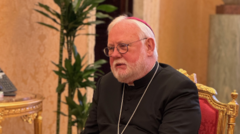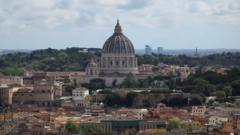On April 26, 2025, communities from around the world gathered in St. Peter's Square, Vatican City, to honor Pope Francis during his funeral. While there were significant tributes to his impactful leadership and messages of inclusivity, the event also highlighted geopolitical tensions as world leaders, some with conflicting views, came together to pay their respects.
Farewell to Pope Francis: A Reflection on His Legacy and the Global Response

Farewell to Pope Francis: A Reflection on His Legacy and the Global Response
Thousands gather to commemorate Pope Francis at his funeral, reflecting on his influence and the complexities surrounding his advocacy.
As the sun rose on April 26, 2025, St. Peter's Square transformed into a site of remembrance, hosting what was expected to be a monumental turnout for the funeral of Pope Francis, who passed away earlier this week at the age of 88. The mass, characterized by moments of solemnity and vibrant displays of faith, drew not only Catholic leaders but also a diverse assembly of global dignitaries and dedicated worshippers, reflecting Francis' lasting impact on the Catholic Church and the world stage.
Pope Francis' tenure marked a significant shift in the Church’s approach to the marginalized, migrants, and issues such as climate change. Under his guidance, the Catholic Church sought to become more inclusive, a transformation that resonated with millions yet faced resistance from conservative factions.
In line with his humble vision, Francis had previously approved a plan for a simpler funeral service, deviating from the extravagant traditions associated with former popes. Nevertheless, the proceedings—which began with a public Mass attended by thousands—still embraced the grandeur of established rites, featuring world leaders and officials from over 150 nations, including notable figures such as U.S. President Donald Trump and Argentina’s President Javier Milei.
Security was a paramount concern for the day, given the expected attendance of numerous heads of state and the current geopolitical climate that has seen tensions rise globally. Attendees included leaders from nations traditionally at odds—like representatives from Russia and Ukraine—prompting careful planning regarding their seating arrangements, which the Vatican organized alphabetically to mitigate any potential discomfort.
After the service, Pope Francis’ body was set to be taken to the Papal Basilica of Santa Maria Maggiore for burial in a simple wooden coffin adorned only with the epitaph “Franciscus,” reflecting his humility. As mourners filled the square—many donning flags representing their countries—there were palpable emotions stemming from Francis' commitment to social justice, compassion for the needy, and criticism of political figures who opposed inclusivity.
As the faithful came together, stories emerged from mourners who described the pope as a source of hope and strength, particularly among the poor and marginalized—groups with whom he constantly identified. The notion of unity extended even amid global divisions served as a poignant reminder of the ideals Francis represented throughout his papacy.
Following this day of mourning, the focus will shift to the selection of his successor, a process fraught with speculation as the College of Cardinals convenes to select a new pope. As his funeral concluded, reflections on Pope Francis’ legacy highlighted both the monumental shifts he enacted within the Church and the ongoing challenges that lie ahead for its followers and leaders. The world watches closely as it grapples with these transitions in faith and leadership, marking the end of an era defined by compassion and activism.






















